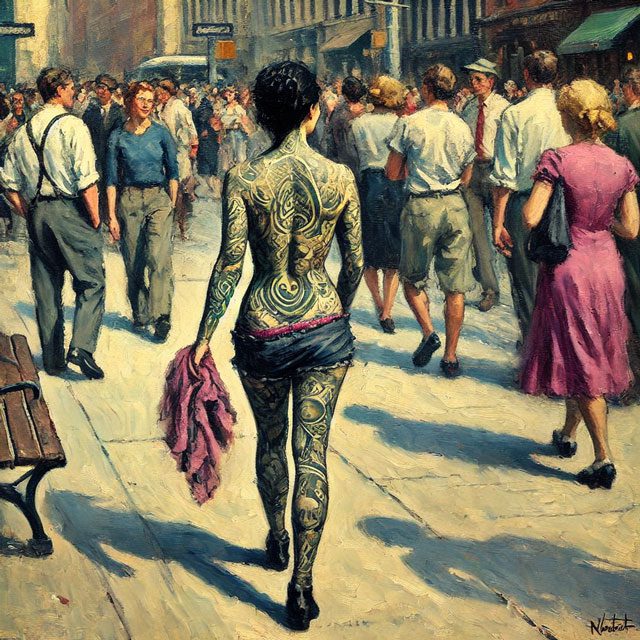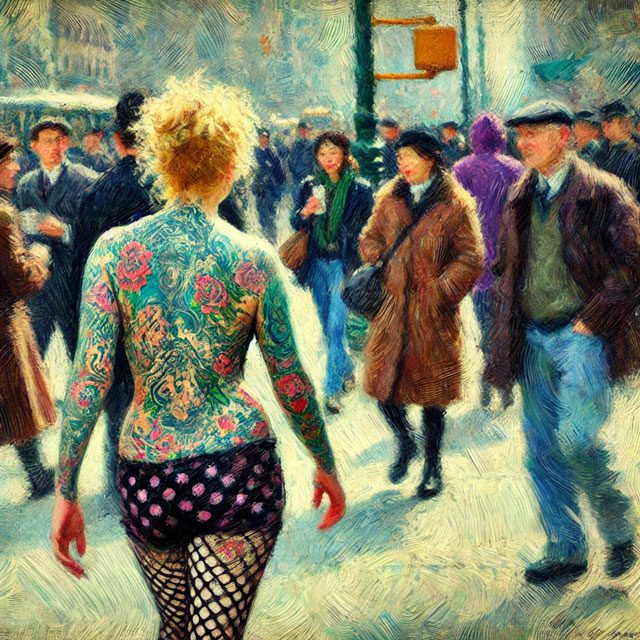
Tattoos have become a booming trend, with more women opting for large, elaborate designs that cover significant portions of their bodies. But let’s not kid ourselves—while some might praise these tattoos as a form of personal expression, many find them outright repulsive. Large tattoos on women are more than just ink on skin; they’re a statement that often turns heads for all the wrong reasons. This article delves into why these oversized body artworks are not just unattractive but downright off-putting.
The History of Tattoos and Gender
Tattoos have a storied past, with roots that stretch back thousands of years. Historically, they were symbols of power, spirituality, and status. But, notably, these symbols were almost always associated with men. Tattoos were often marks of warriors, sailors, and religious figures—roles firmly held by men. Women with tattoos were a rarity, and when they did have them, they were subtle and deeply personal, not the glaring, attention-seeking displays we see today.
In some ancient cultures, a woman with a tattoo might have been considered beautiful or high-status. For example, in ancient Egypt, women of high rank sometimes bore small tattoos believed to offer protection during childbirth. But even then, these tattoos were discreet and symbolic, not the garish designs splashed across arms, legs, and backs that we see now.
As time moved on, particularly in Europe during the Middle Ages, tattoos became associated with criminals and outcasts. This association wasn’t gender-specific, but the idea of a tattooed woman became even more taboo. For centuries, women were expected to embody purity and modesty—two qualities that large, brash tattoos certainly do not convey.
Fast forward to today, and while tattoos have lost much of their criminal stigma, they have taken on a new form of rebellion. Women with large tattoos are often seen as challenging societal norms—but not in a good way. Instead of being seen as empowered or strong, they are often viewed as trying too hard to make a statement, and in doing so, they lose the elegance and grace that many still value in women.
The Psychological Impact of Large Tattoos on Perception
There’s no denying it—first impressions matter. When a woman with large, visible tattoos walks into a room, those tattoos often become the focal point, overshadowing everything else about her. The human brain is wired to make snap judgments, and large tattoos trigger a host of negative associations for many people.
From a psychological standpoint, large tattoos can be perceived as a form of aggression. The sheer size and prominence of the tattoo demand attention and can be overwhelming. It’s as if the tattoo is shouting at you, “Look at me!” This kind of in-your-face attitude can be off-putting, especially in social situations where subtlety and decorum are valued.

Moreover, large tattoos can create cognitive dissonance. On one hand, society teaches us to appreciate beauty, elegance, and simplicity in women. On the other hand, we are confronted with these massive, often chaotic designs that seem to contradict these ideals. This clash between expectation and reality can leave many feeling uneasy or even repelled.
There’s also the issue of body image. Tattoos are permanent, and large tattoos, in particular, drastically alter a woman’s appearance. What might seem like a bold statement in her 20s can become a regret in her 40s. The permanence of tattoos forces a person to live with a decision that may no longer align with their identity as they age. For many, this permanence can be seen as a sign of poor judgment or impulsivity—qualities that are far from admirable.
Cultural and Social Influences on Tattoo Perceptions
The media plays a significant role in shaping our perceptions of large tattoos on women, and let’s be honest—it’s not always positive. While some might argue that tattoos are celebrated in pop culture, the truth is that these representations often lean toward the extreme. Women with large tattoos are frequently depicted as rebellious, dangerous, or outliers of society—images that don’t exactly scream “role model.”
Movies and TV shows often portray tattooed women as edgy or alternative, but this is a double-edged sword. While it might appeal to some subcultures, it alienates a larger portion of the population who associate these tattoos with a lack of sophistication. The media might glorify the tattooed “bad girl,” but this is far from the image most women aspire to project.
Cultural norms also play a huge role in how we view tattoos on women. In many Western societies, there’s still a strong undercurrent of conservatism when it comes to female beauty standards. Large tattoos are often seen as a departure from traditional femininity, which values subtlety, softness, and refinement. Instead of enhancing a woman’s beauty, large tattoos are viewed as distractions that detract from her natural appeal.
Social stigmas surrounding large tattoos on women are hard to shake. Even in more liberal circles, there’s often an unspoken judgment passed on women who choose to cover their bodies in ink. The common perception is that these women are seeking attention or trying too hard to assert their independence—actions that are more often met with criticism than admiration. In a world that still places a high value on a woman’s appearance, large tattoos can be seen as a misguided attempt to stand out, rather than an expression of individuality.
Case Studies: Public Figures and Large Tattoos
When we look at celebrities with large tattoos, the public reaction is often telling. Take Angelina Jolie, for example. While she’s undoubtedly a talented actress and humanitarian, her large tattoos have frequently been the subject of scrutiny. Some see her body art as a reflection of her rebellious spirit, but many others view it as a distraction from her natural beauty and sophistication.
Similarly, Ruby Rose, known for her striking appearance and extensive tattoos, has become an icon in certain subcultures. However, outside of those circles, her tattoos often elicit mixed reactions. While she is celebrated for her androgynous style and bold personality, her tattoos also reinforce a perception of her as someone who is constantly pushing boundaries—often at the cost of broader appeal.
Even Lady Gaga, known for her boundary-pushing fashion choices, has faced backlash for her large tattoos. While her fans might see them as part of her artistic persona, others find them jarring, detracting from her talent and overshadowing her performances.
These examples highlight a common theme: large tattoos on women are rarely met with unanimous praise. Instead, they polarize public opinion and often serve as a lightning rod for criticism. While these women might be celebrated in certain circles, their tattoos often limit their appeal to a broader audience. This reinforces the idea that large tattoos, rather than enhancing a woman’s image, often do the opposite.
The Impact of Large Tattoos on Relationships and Career
Let’s talk about how large tattoos can affect a woman’s personal life and career. In relationships, first impressions are crucial, and large tattoos can be a deal-breaker for many. While some might argue that a tattoo is a form of self-expression, others see it as a glaring red flag. The boldness of large tattoos can signal a rebellious nature or a need for attention—traits that aren’t universally attractive.
In dating, large tattoos can be polarizing. Some potential partners may be intrigued, but many others are likely to be put off. Tattoos, especially large ones, can give the impression of a woman who is difficult to understand or who thrives on being different for the sake of it. For those seeking a long-term relationship, this can be a significant deterrent.
The workplace is another arena where large tattoos can have a significant impact. Despite the growing acceptance of tattoos, many employers still view them as unprofessional, especially in conservative industries. A woman with large tattoos may find herself at a disadvantage when applying for jobs or seeking promotions. The tattoos can overshadow her qualifications, leading to assumptions about her character and professionalism that may not be accurate.
Even in industries that are more accepting of tattoos, large tattoos on women can still be a point of contention. They can create an impression that the woman is more focused on her appearance than her work, or that she is trying to make a statement rather than fit into a team. This perception can hinder career advancement and limit opportunities, regardless of the woman’s actual skills and abilities.
Are Large Tattoos on Women Here to Stay?
Despite the negative perceptions, large tattoos on women aren’t going anywhere anytime soon. They are part of a broader trend towards body modification and self-expression that shows no signs of slowing down. However, just because something is popular doesn’t mean it’s universally accepted—or even attractive.
Trends come and go, and it’s likely that the current fascination with large tattoos will eventually fade. As societal norms shift, the backlash against these tattoos may grow stronger, leading to a decline in their popularity. What’s seen as bold and rebellious today could be viewed as dated and unappealing tomorrow.

Moreover, as more women who got large tattoos in their youth age, the realities of living with such permanent body art will become more apparent. The sagging skin, the faded ink, and the changes in personal style will all contribute to a reevaluation of whether these large tattoos were a good idea in the first place.
In the end, while large tattoos on women might be trendy now, they are far from universally admired. For many, they remain a source of repulsion rather than admiration—a permanent reminder of a decision that might not stand the test of time.
Conclusion
Large tattoos on women are undeniably polarizing. While some might see them as a form of self-expression or empowerment, the reality is that many people find them repulsive. These tattoos challenge traditional notions of femininity and often create a barrier to acceptance in both personal and professional spheres. The history, psychology, and cultural perceptions surrounding large tattoos all contribute to this negative view.
As trends evolve and societal norms shift, it’s likely that the current fascination with large tattoos will wane. Those who choose to ink their bodies in such a bold way may find themselves facing more criticism than praise as time goes on. As Coco Chanel once said, “Elegance is refusal.” Sometimes, less truly is more.




